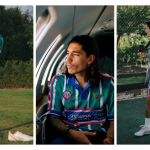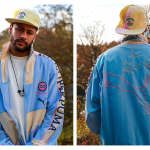
Why was 2020 the year of PUMA?
3 reasons why the German company is the sport brand of the year
November 25th, 2020
When PUMA left the Forbes Fab 40 in 2016 - the ranking dedicated to the most valuable brands in sports - its fate seemed almost sealed. The strength that the German brand has regained within 4 years has been greater than expected. In addition to re-entering the rankings last year, remaining behind only Nike, ESPN, adidas, Gatorade and Sky Sports, PUMA has developed strategies that have helped to make Herzogenaurach's company one of the fastest growing of this 2020. The covid- 19, in some ways, acted as an accelerator from many points of view: according to Business of Fashion, the brand adjusted +20.7% and +17.7% in sales respectively in the US and European markets, bringing the turnover in the first quarter of 2020 beyond forecasts (1.58 billion against the 1.56 billion expected). A growth that, despite the period, brought a profit of 190 million euros to the German coffers, improving estimates by 16 million.
In all key sectors of modern society, there is an unwritten law that can be applied with the same meaning: when in trouble, go big. There is no better expression that summarizes the need to have courage to take risks in moments of crisis, transforming complications into opportunities. And that's what PUMA has done in 2020, unlike competitors who have opted for other paths. Nike is implementing strategies that no longer place individual faces at the center of projects but entire communities, thinking by key city and no longer by key player. They think differently in Stuttgart, adidas' HQ. The three stripes are shifting the focus more and more on art and artists, exploiting their personalities and their creativity for increasingly transversal collaborations.
2020-21 kit: quality and identity
The kits for the 2020-21 season took longer than expected, given the delays caused by the global pandemic, but despite everything they marked obvious trends. PUMA was the winner in the special quality / identity category because it was able to interpret better than its competitors the need to integrate local culture - whether it is fashion as in the case of AC Milan or artistic as in the case of Manchester City - and an increasingly less "element fot the pitch” and more and more street style like the shirt. The cases of Borussia Dortmund, Olympique Marseille, Valencia, as well as those of the Italian and Iceland national team (with whom he worked on a more general rebranding), have contributed to making PUMA kits the best of 2020. The architectural elements, often symbols identity for fans and local communities, they have transmitted that sense of belonging that has always been the basis of the football faith. Milanese haute couture, Manchester mosaics, the meeting point for all BVB fans, the unmistakable style of Le Corbusier's structures, the art of the Italian Renaissance: all winning aspects.
A new generation of players
PUMA's new strategies required huge investments to return to the ancient glories, when every footballer dreamed of wearing the King, the most iconic model of the brand made immoral by talents such as Pelé, Maradona and Cruyff. Those moments of glory seem to be back, considering the new "PUMA Athlete" stable around the world: Griezmann, Suárez, Bellerín, Agüero, Giroud, Chiellini, Payet, Henry, Buffon, most likely Lewandowski and Sterling, but especially Neymar from Silva Santos Júnior. The PSG striker has requested resources never seen before, becoming the highest paid testimonial in football history with the 25 million euros per season that comes from PUMA - even exceeding the 19 that adidas pours into Messi's coffers and 16 of Nike for CR7. Having lost sporting symbols such as Usain Bolt over the years has forced the company founded by Rudolf Dassler to reschedule all plans. And when the world goes faster than your thought, go big: take risks, dare and turn the situation around.
The new generation also connects to the new speed of execution and decision-making of PUMA's management. In an interview with L’Equipe, the CEO of the company Bjorn Gulden revealed some background on the most economically important agreement in the history of sports endorsements and among these there is precisely the concept of decision-making speed:
"It was his father and his management who approached us. And, of course, when Neymar's team calls, you answer. [...] When his entourage informed us that he would probably leave Nike, we replied that we would be happy to discuss it, but only when his relationship with Nike would be permanently closed. By the time we were assured that it was, the deal went very quickly. Now let's make our decisions quickly. This crisis caused by covid-19 has revealed who is flexible and who is not. The deal with Neymar surprised a lot because people didn't realize he was leaving Nike and didn't expect PUMA to go that fast."
Bjorn Gulen, PUMA Chief Execution Officer
In just 30 days, PUMA managed to go from the first contacts to a complete shooting to announce the signing of O’Ney. The first negotiations had begun in mid-August and on 12 September the signing of PSG's Diez was on the new contract.
The power of marketing and social media
The climb to the heights of a constantly evolving market began in early 2010, when the new millennium is concise with a change in marketing and communication strategies that have changed the face of the brand. New target, new language and a form of dialogue with the market that for years has marked the difference between PUMA and the two giants Nike and adidas. In 2017, however, the first important results arrived: in the study on the influence of clothing brands on social networks made by Insightpool, PUMA ranked fourth, behind Louis Vuitton, Chanel, Christian Siriano but ahead of the two main competitors.
The growth on social media was followed by the evolution of content which in recent seasons is on a par with that of the swoosh and three stripes. The quality of the campaigns - whether they are dedicated to clubs or to launches of new collections or collaborations - has improved in a way that is directly proportional to PUMA's brand reputation. Creative ideas are linked both to the company's roots and to the future of the collaborations, as evidenced by the collections with KidSuper, the partnership with Rhude and the launch of great classics reinvented in a modern key. The social engagement of players has also changed over time, as evidenced by a letter from a young Neymar in which he tells the dream of dressing PUMA to be like his childhood idols. There is everything: the heritage of a historical brand, the most glorious years and the future that belongs more and more to the star par excellence of the new generations.








































.png)


.jpg)

























































































